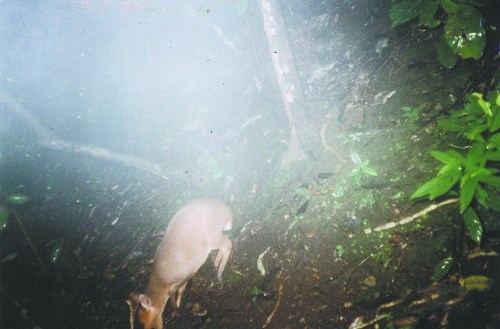The Huaping Nature Reserve in Guilin, in south China's Guangxi Zhuang Autonomous Region, recently announced that seven infrared cameras donated by a Hong Kong botanical garden had produced many snapshots of wild animals, some of which had been considered "extinct" in the area, the Guilin Evening News reported on July 15.
 |
|
This picture taken by an infrared camera shows a forest musk deer, which is under state class-I protection.
|
Located 70 kilometers from Guilin and covering an area of about 15,000 hectares, the nature reserve is home to 315 wildlife species, 39 of which are under state protection and 75 under provincial-level protection.
In early 2008, a severe snowstorm swept through central, eastern and southwestern China, wreaking havoc and damaging the living environment of many wild animals. Workers later found several hundred wild animals had died, and many others had suffered from frostbite.
The storm severely damaged local plants and vegetation, affecting the animals'food chain. Since the storm, it has been hard to find traces of certain animals in the wilderness, as they have become more sensitive to human activities. This makes it difficult for zoologists to conduct scientific appraisals of their survival prospects.
Learning of the storm's affects, the Kadoorie Farm & Botanical Garden in Hong Kong donated seven infrared cameras to the Huaping Nature Reserve.
The palm-sized, high-tech cameras can withstand strong wind and rain. They respond to the passage of wild animals and take photographs automatically. The cameras can even produce quality photos in the dark, which is when many animals venture out to feed.
In January of this year, the cameras were installed in the areas of Zujiang, Hongtan, Anjiangping and Yuhai, places that have traditionally had a heavy density of wild animals.
Zhang Dingheng, a reserve worker, said that he installed one of the cameras on a cliff at 1,110 meters above sea level by the Yanshan River. The land near the river is inhabited by stump-tailed monkeys under state class-II protection.
In mid-May, after developing the films, Zhang and his colleagues were delighted to find that the camera had taken snapshots not only of stump-tailed monkeys, but also of forest musk deer under state class-I protection, and serow and silver pheasant under state class-II protection.
"It is really a rare opportunity to find pictures of so many rare, wild animals on only one film in one camera in one place," said Zhang. "The serow is a kind of animal especially sensitive to human activities. Their habitats are sheer precipices and overhanging rocks. It's hard to find any trace of them, so we thought they might have become extinct."
Zhang said the camera took three pictures of different serows, with the largest serow estimated to be as heavy as 130 kilograms. "The evidence has verified that this kind of rare, wild animal still exists in the nature reserve," he said.
An official of the nature reserve said that the infrared cameras play an important role in helping scientific research personnel in mapping the survival situation of the wild animals in the area and in drawing up the appropriate protective measures that need to be taken.